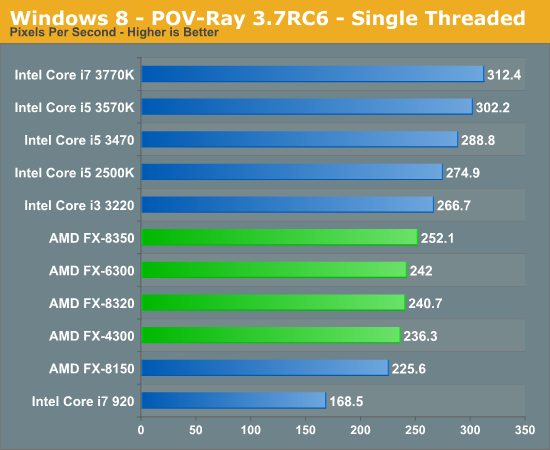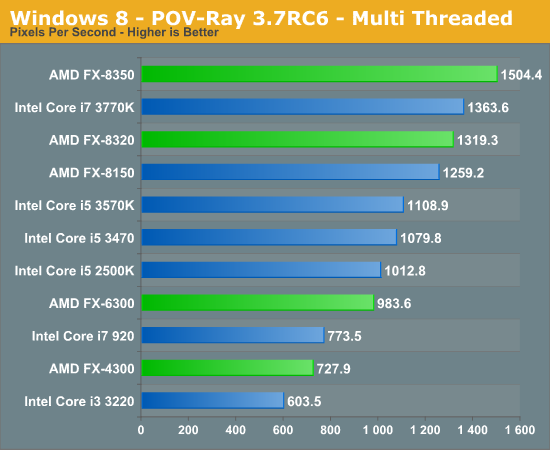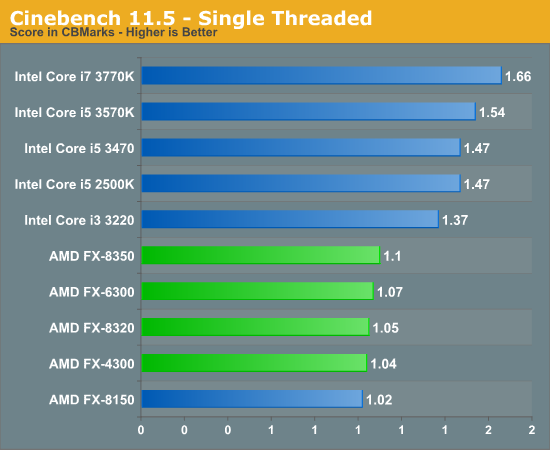The Vishera Review: AMD FX-8350, FX-8320, FX-6300 and FX-4300 Tested
by Anand Lal Shimpi on October 23, 2012 12:00 AM ESTPhotoshop Performance
Adobe Photoshop CS4
To measure performance under Photoshop CS4 we turn to the Retouch Artists’ Speed Test. The test does basic photo editing; there are a couple of color space conversions, many layer creations, color curve adjustment, image and canvas size adjustment, unsharp mask, and finally a gaussian blur performed on the entire image.
The whole process is timed and thanks to the use of Intel's X25-M SSD as our test bed hard drive, performance is far more predictable than back when we used to test on mechanical disks.
Time is reported in seconds and the lower numbers mean better performance. The test is multithreaded and can hit all four cores in a quad-core machine.

We see similar results in our Photoshop benchmark, Vishera falls behind a bit as this test isn't threaded enough to showcase the platform's advantages.
3D Rendering Performance
Our new POV-Ray benchmark uses the latest beta binary (3.7RC6) and runs through both single and multithreaded versions of the popular raytracing benchmark.

The latest POV-Ray test gives us a good look at single threaded performance. Here AMD was able to increase performance over the FX-8150 by 11%, however Intel's Core i5 3570K still manages to hold on to a 20% performance lead over the FX-8350.

Running the same benchmark but multithreaded puts AMD at the top. With the exception of the FX-6300, all of the AMD parts beat out their Intel counterparts.
Cinebench 11.5
Created by the Cinema 4D folks we have Cinebench, a popular 3D rendering benchmark that gives us both single and multi-threaded 3D rendering results.

Cinebench 11.5 paints an even more dire picture for AMD's single threaded performance - Intel manages a 40% advantage over the FX-8350.

Multithreaded performance however continues to be great.










250 Comments
View All Comments
wwwcd - Tuesday, October 23, 2012 - link
Yes, we don't neeed of 8 core/threads for gaming today, but do You have prognosis for near future?
Kisper - Tuesday, October 23, 2012 - link
Why would you upgrade for no reason other than speculation?If an advantage arises in heavily threaded games in the future, upgrade at that time. You'll get more processing power / $ spent in the future than you will at present.
CeriseCogburn - Tuesday, October 30, 2012 - link
amd fanboys are pennywise and pound foolish, so buying the amd crap now, and telling everyone it has the deranged amd furuteboy advantage, works for them !I mean really, it sucks so freaking bad, they cannot help themselves, like a crack addict they must have and promote, so heck, the last hope of the loser is telling everyone how bright they are and how on down the line in the imaginary years ahead their current pileofcrap will "truly shine!"
LOL - oh man, funny but so true.
Spunjji - Tuesday, October 23, 2012 - link
Prognosis for the near future is that having that many threads will still not be a whole lot of use for gaming. See Amdahl's law for why.Samus - Tuesday, October 23, 2012 - link
It's safe to say all programs/games going forward will take advantage of four cores or more. Battlefield 3 released LAST year and basically requires 4 cores in order to be GPU-limited (as in the game is CPU limited with just about any videocard unless you have 4 cores.c0d1f1ed - Tuesday, October 23, 2012 - link
Amdahl's Law is not a reason. There is plenty of task parallelism to exploit. The real issue is ROI, and there's two aspects to that. One is that multi-threaded development is freakishly hard. Unlike single-threaded development, you cannot know exactly what each thread is doing at any given time. You need to synchronised to make certain actions deterministic. But even then you can end up with race conditions if you're not careful. The current synchronization methods are just very primitive. Intel will fix that with Haswell. The TSX technology enables hardware lock elision and hardware transactional memory. Both will make the developer's life a lot easier, and also make synchronization more efficient.
The second aspect isn't about the costs but about the gains. It has taken quite a while for more than two cores to become the norm. So it just wasn't worth it for developers to go through all the pain of scalable fine-grained multi-threaded development if the average CPU is still only a dual-core. Haswell's TSX technology will come right in time as quad-core becomes mainstream. Also, Haswell will have phenomenal Hyper-Threading performance thanks to two nearly symmetrical sets of two integer execution units.
AMD needs to implement TSX and AVX2 sooner rather than later to stay in the market.
CeriseCogburn - Tuesday, October 30, 2012 - link
Nice post. Appreciate it.And ouch for amd once again.
surt - Tuesday, October 23, 2012 - link
No, gaming won't need that many threads in the near future either. Nobody is going to make a game demand more than 4 threads because that's what common gamer systems support.AnnihilatorX - Wednesday, October 24, 2012 - link
I disagree. Say we have a hypothetical game that support 8 threads. The overhead of over-threading in a quad core system is frankly, not very much, while it may provide improvements on people with octocore or Intel processors with hyper-threading.AnnihilatorX - Wednesday, October 24, 2012 - link
In fact, there are many games nowadays that split workload into many threads for economic simulation, background AI planning in user phase, physics, audio, graphics subthread, network management, preloading and resources management. It is just that even with the parallelism, there bound to be bottlenecks in single threading that a 8 core may not benefit at all compared to 4 cores.So I disagree, it is not about people not spending resources in making parallelism or not supporting it. It is the nature of the workload that is the determining factor.